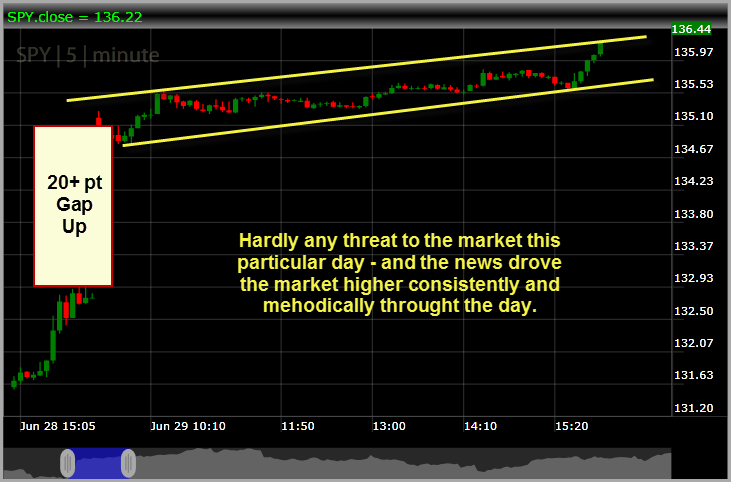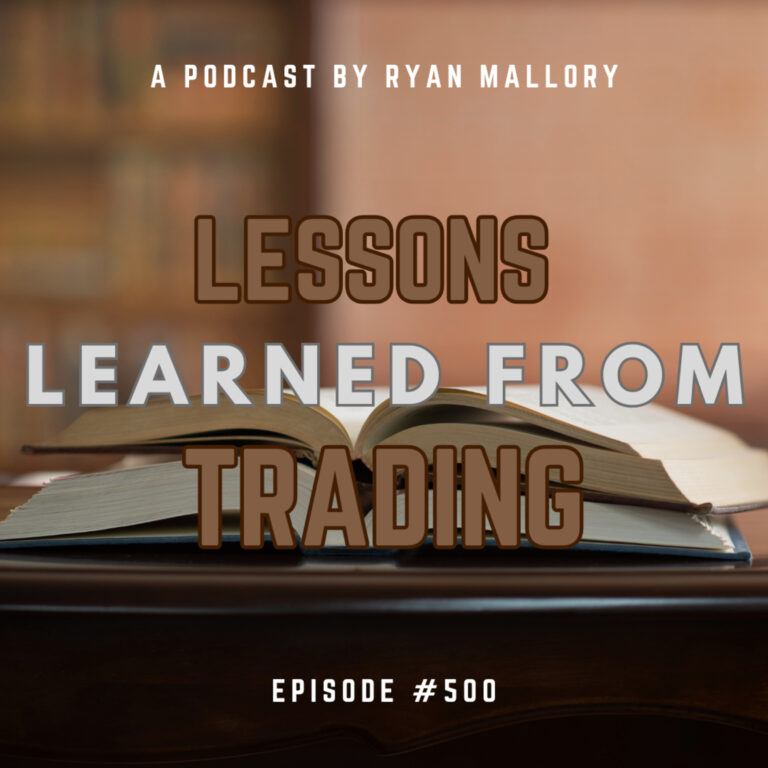Discussing large market gaps higher
Let’s get started on Part 2 of How to Predict Market Action From the 1st Hour of Trading by discussing the Heavy Market Gap-Ups.
You’ll remember yesterday how I discussed gap-downs can be very difficult for the bears to hold on to the weakness. So the obvious conclusion then is that bulls would have a difficult job of holding on to gap-ups. But that comparison really doesn’t work with gap-ups. They are completely different in personality and how the market responds to them.
There are a lot of major players in the market with tons of buying power that simply cannot short the market or any stock for that matter. As a result, the only choice they have is to buy or sell (short/cover isn’t a viable option).
These same entities (like mutual funds & some hedge funds to name a few), in order to remain relevant, need to BEAT the S&P (assuming most use that as their benchmark that they are measured against) or AT LEAST match the S&P 500 returns.

Therefore when the market gaps up and if they aren’t fully capitalized… guess what they are going to do? That’s right… They are going to CHASE the S&P which thereby leads to additional buying.
So let’s further examine this market condition and what you can learn from it.
- Strong Gap-Ups are much harder to reverse to the downside than Gap downs are to the upside. Why?
- Strong gap-up is typically of more than 1.0%
- Funds of all types see the gap-up and make emotional decisions to chase the market throughout the day. Those who wait are eventually sucked in at some point in fear of missing a larger move and justify their buying with the belief the market rally could be multi-day.
- Most traders and investors are long-types only, so like the funds, they are prone to chase, even though they may not be forced to meet S&P 500 benchmarks, there is still the fear of ‘missing-out’. Adding additional buying power.
- With all this additional buying power, there are plenty out there who will use the gap up and the strength that it provides to sell out of some of their existing positions, but most times, the buying power coming from the chasers will keep the market trading in at least a sideways channel.
- Usually these gap-ups can be rather boring days for traders, as they will have a lot of their ‘trigger-prices’ nullified by the stocks gapping through them.
- A particular scenario where the aforementioned does not apply is typically in bear markets in a well-defined downtrend – where bears have full control of the market, very confident, and are specifically LOOKING for gap-ups and early morning rallies to short the dickens out of. In these cases, what BULLS are looking for any pop to get out of their existing positions which adds to renewed selling despite the gap-up.
The Result: There are times as well when the market will flounder after that gap up, possibly even fill the gap and bounce right back, and not sell-off per se, but those instances don’t happen nearly as much. The chances that a strong gap-up stays a strong gap and consolidates or even builds upon its opening price is about 65% likelihood. Chances of a complete reversal and ending lower is 15%, and the chances of it floundering somewhere above breakeven and the opening price is around 20%

By the way folks, it’s important to remember that ultimately the market does whatever it rightfully wants to do.
What I’m providing you with in this series is not some fail-safe mechanism to trading but a navigational tool for trading these financial markets.
Become part of the Trading Block and get my trades, and learn how I manage them for consistent profits. With your subscription you will get my real-time trade setups via Discord and email, as well as become part of an incredibly helpful and knowledgeable community of traders to grow and learn with. If you’re not sure it is for you, don’t worry, because you get a Free 7-Day Trial. So Sign Up Today!

Welcome to Swing Trading the Stock Market Podcast!
I want you to become a better trader, and you know what? You absolutely can!
Commit these three rules to memory and to your trading:
#1: Manage the RISK ALWAYS!
#2: Keep the Losses Small
#3: Do #1 & #2 and the profits will take care of themselves.
That’s right, successful swing-trading is about managing the risk, and with Swing Trading the Stock Market podcast, I encourage you to email me (ryan@shareplanner.com) your questions, and there’s a good chance I’ll make a future podcast out of your stock market related question.
In today's episode, at episode 500, I am diving into the lessons learned from trading over the last 100 episodes, because as traders we are evolving and always attempting to improve our skillset. So here is to episode 500, and to another 500 episodes of learning and developing as swing traders in the stock market!
Be sure to check out my Swing-Trading offering through SharePlanner that goes hand-in-hand with my podcast, offering all of the research, charts and technical analysis on the stock market and individual stocks, not to mention my personal watch-lists, reviews and regular updates on the most popular stocks, including the all-important big tech stocks. Check it out now at: https://www.shareplanner.com/premium-plans
📈 START SWING-TRADING WITH ME! 📈
Click here to subscribe: https://shareplanner.com/tradingblock
— — — — — — — — —
💻 STOCK MARKET TRAINING COURSES 💻
Click here for all of my training courses: https://www.shareplanner.com/trading-academy
– The A-Z of the Self-Made Trader –https://www.shareplanner.com/the-a-z-of-the-self-made-trader
– The Winning Watch-List — https://www.shareplanner.com/winning-watchlist
– Patterns to Profits — https://www.shareplanner.com/patterns-to-profits
– Get 1-on-1 Coaching — https://www.shareplanner.com/coaching
— — — — — — — — —
❤️ SUBSCRIBE TO MY YOUTUBE CHANNEL 📺
Click here to subscribe: https://www.youtube.com/shareplanner?sub_confirmation=1
🎧 LISTEN TO MY PODCAST 🎵
Click here to listen to my podcast: https://open.spotify.com/show/5Nn7MhTB9HJSyQ0C6bMKXI
— — — — — — — — —
💰 FREE RESOURCES 💰
— — — — — — — — —
🛠 TOOLS OF THE TRADE 🛠
Software I use (TC2000): https://bit.ly/2HBdnBm
— — — — — — — — —
📱 FOLLOW SHAREPLANNER ON SOCIAL MEDIA 📱
*Disclaimer: Ryan Mallory is not a financial adviser and this podcast is for entertainment purposes only. Consult your financial adviser before making any decisions.




